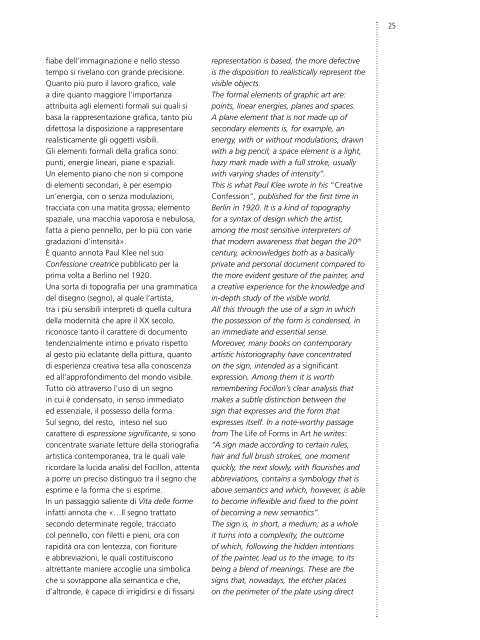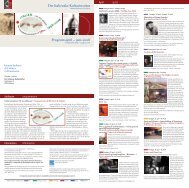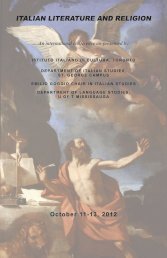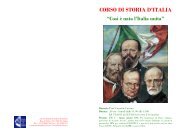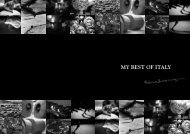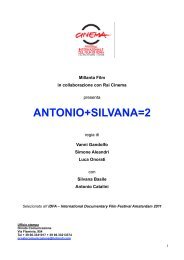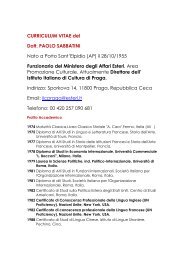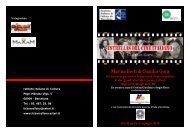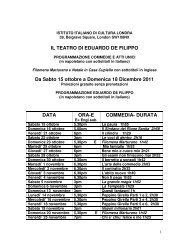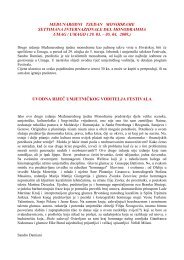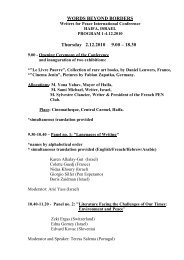Untitled - Ministero degli Affari Esteri
Untitled - Ministero degli Affari Esteri
Untitled - Ministero degli Affari Esteri
Create successful ePaper yourself
Turn your PDF publications into a flip-book with our unique Google optimized e-Paper software.
fiabe dell’immaginazione e nello stesso<br />
tempo si rivelano con grande precisione.<br />
Quanto più puro il lavoro grafico, vale<br />
a dire quanto maggiore l’importanza<br />
attribuita agli elementi formali sui quali si<br />
basa la rappresentazione grafica, tanto più<br />
difettosa la disposizione a rappresentare<br />
realisticamente gli oggetti visibili.<br />
Gli elementi formali della grafica sono:<br />
punti, energie lineari, piane e spaziali.<br />
Un elemento piano che non si compone<br />
di elementi secondari, è per esempio<br />
un’energia, con o senza modulazioni,<br />
tracciata con una matita grossa; elemento<br />
spaziale, una macchia vaporosa e nebulosa,<br />
fatta a pieno pennello, per lo più con varie<br />
gradazioni d’intensità».<br />
È quanto annota Paul Klee nel suo<br />
Confessione creatrice pubblicato per la<br />
prima volta a Berlino nel 1920.<br />
Una sorta di topografia per una grammatica<br />
del disegno (segno), al quale l’artista,<br />
tra i più sensibili interpreti di quella cultura<br />
della modernità che apre il XX secolo,<br />
riconosce tanto il carattere di documento<br />
tendenzialmente intimo e privato rispetto<br />
al gesto più eclatante della pittura, quanto<br />
di esperienza creativa tesa alla conoscenza<br />
ed all’approfondimento del mondo visibile.<br />
Tutto ciò attraverso l’uso di un segno<br />
in cui è condensato, in senso immediato<br />
ed essenziale, il possesso della forma.<br />
Sul segno, del resto, inteso nel suo<br />
carattere di espressione significante, si sono<br />
concentrate svariate letture della storiografia<br />
artistica contemporanea, tra le quali vale<br />
ricordare la lucida analisi del Focillon, attenta<br />
a porre un preciso distinguo tra il segno che<br />
esprime e la forma che si esprime.<br />
In un passaggio saliente di Vita delle forme<br />
infatti annota che «…Il segno trattato<br />
secondo determinate regole, tracciato<br />
col pennello, con filetti e pieni, ora con<br />
rapidità ora con lentezza, con fioriture<br />
e abbreviazioni, le quali costituiscono<br />
altrettante maniere accoglie una simbolica<br />
che si sovrappone alla semantica e che,<br />
d’altronde, è capace di irrigidirsi e di fissarsi<br />
representation is based, the more defective<br />
is the disposition to realistically represent the<br />
visible objects.<br />
The formal elements of graphic art are:<br />
points, linear energies, planes and spaces.<br />
A plane element that is not made up of<br />
secondary elements is, for example, an<br />
energy, with or without modulations, drawn<br />
with a big pencil; a space element is a light,<br />
hazy mark made with a full stroke, usually<br />
with varying shades of intensity”.<br />
This is what Paul Klee wrote in his “Creative<br />
Confession”, published for the first time in<br />
Berlin in 1920. It is a kind of topography<br />
for a syntax of design which the artist,<br />
among the most sensitive interpreters of<br />
that modern awareness that began the 20 th<br />
century, acknowledges both as a basically<br />
private and personal document compared to<br />
the more evident gesture of the painter, and<br />
a creative experience for the knowledge and<br />
in-depth study of the visible world.<br />
All this through the use of a sign in which<br />
the possession of the form is condensed, in<br />
an immediate and essential sense.<br />
Moreover, many books on contemporary<br />
artistic historiography have concentrated<br />
on the sign, intended as a significant<br />
expression. Among them it is worth<br />
remembering Focillon’s clear analysis that<br />
makes a subtle distinction between the<br />
sign that expresses and the form that<br />
expresses itself. In a note-worthy passage<br />
from The Life of Forms in Art he writes:<br />
“A sign made according to certain rules,<br />
hair and full brush strokes, one moment<br />
quickly, the next slowly, with flourishes and<br />
abbreviations, contains a symbology that is<br />
above semantics and which, however, is able<br />
to become inflexible and fixed to the point<br />
of becoming a new semantics”.<br />
The sign is, in short, a medium; as a whole<br />
it turns into a complexity, the outcome<br />
of which, following the hidden intentions<br />
of the painter, lead us to the image, to its<br />
being a blend of meanings. These are the<br />
signs that, nowadays, the etcher places<br />
on the perimeter of the plate using direct<br />
25


